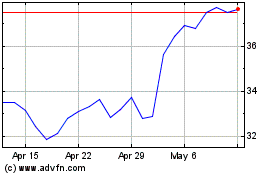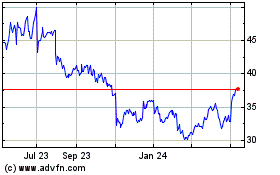BorgWarner Technology Boosts Growth of Gasoline-Engine Turbocharging
March 14 2007 - 11:36AM
PR Newswire (US)
AUBURN HILLS, Mich., March 14 /PRNewswire-FirstCall/ -- Advances in
turbocharger design, manufacturing and materials are expected to
boost the growth of turbocharged gasoline direct injected engines
by 30% over the next five years, according to industry experts and
BorgWarner, a leader in turbocharging technology. "Gasoline-engine
turbocharging is not focused exclusively on increasing engine
output, but also on combining exceptional engine performance with
fuel economy," said Roger Wood, President and General Manager,
BorgWarner Turbo & Emissions Systems. "These are among the most
important challenges facing automakers all over the world.
BorgWarner is at the forefront of the industry in terms of
providing the technology solutions that enable our customers to
meet the challenges of improving fuel economy and engine
performance. In addition to conventional turbochargers, variable
turbine geometry (VTG) technology will play a significant role in
gasoline engines." Several automakers around the globe are
exploring application possibilities for VTG technology in gas
engines. BorgWarner is leveraging its expertise in air management
technology to ensure that the company is well- positioned to make
the most of these opportunities. Worldwide, the use of turbocharged
gasoline direct injected engines is expected to grow to 2 million
engines in 2011 from about half a million in 2006. About 70% of
these engines are expected to be produced in Europe, with the rest
of the production in Japan, China and North America. Downsized
gasoline engines with VTG technology can achieve the same output
and dynamic engine response as normally aspirated engines with a
larger displacement. At the same time, these improvements are
achieved with much lower fuel consumption. Fuel savings is
estimated at 15 and 20 percent compared to a larger traditional or
port injected gasoline engine without a turbocharger. Until
recently, VTG technology was limited to diesel engines. The
technical challenge lay in developing materials capable of
withstanding the much higher exhaust gas temperatures that are
generated in gasoline engines. In cooperation with Porsche,
BorgWarner Turbo & Emissions Systems succeeded in developing
the first turbocharger with VTG technology for the Porsche 911
Turbo. The key feature of the turbocharger is its adjustable guide
vanes. The innovative design means that at low engine speeds and
low exhaust gas flow rates, the vanes in a closed position develop
a high boost pressure. This pressure falls as the vanes are opened.
As a result, the bypass system with the wastegate valve that is a
feature of conventional turbochargers can be eliminated. The entire
exhaust gas flow can then pass through the turbine wheel and be
immediately converted into increased boosting. This considerably
improves engine response in the lower rpm range, compared to a
conventional turbocharger with a wastegate typically used in
gasoline applications. To address the challenge of high exhaust
temperature, BorgWarner used high- temperature-resistant alloys for
the VTG cartridge and vanes, materials which are also used in
aviation and space technology. Following the successful debut of
its gasoline VTG unit in the Porsche 911 Turbo, BorgWarner Turbo
& Emissions Systems expects this technology to become
established on a broad number of applications over the next ten
years. BorgWarner Turbo & Emissions Systems is a leading global
producer of turbochargers and other engine air management systems
for passenger cars, light trucks and commercial vehicles. These
systems are designed to improve fuel economy, reduce emissions and
enhance vehicle performance. Auburn Hills, Michigan-based
BorgWarner Inc. (NYSE:BWA) is a product leader in highly engineered
components and systems for vehicle powertrain applications
worldwide. The FORTUNE 500 company operates manufacturing and
technical facilities in 63 locations in 18 countries. Customers
include Ford, VW/Audi, DaimlerChrysler, General Motors, Toyota,
Renault/Nissan, Hyundai/Kia, Honda, BMW, Caterpillar, Navistar
International, and Peugeot. The Internet address for BorgWarner is:
http://www.borgwarner.com/. Statements contained in this news
release may contain forward-looking statements as contemplated by
the 1995 Private Securities Litigation Reform Act that are based on
management's current expectations, estimates and projections. Words
such as "expects," "anticipates," "intends," "plans," "believes,"
"estimates," variations of such words and similar expressions are
intended to identify such forward-looking statements.
Forward-looking statements are subject to risks and uncertainties,
many of which are difficult to predict and generally beyond the
control of the Company, that could cause actual results to differ
materially from those expressed, projected or implied in or by the
forward-looking statements. Such risks and uncertainties include:
fluctuations in domestic or foreign automotive production, the
continued use of outside suppliers by original equipment
manufacturers, fluctuations in demand for vehicles containing the
Company's products, general economic conditions, as well as other
risks detailed in the Company's filings with the Securities and
Exchange Commission, including the Risk Factors identified in its
most recently filed annual report or Form 10-K. The Company does
not undertake any obligation to update any forward-looking
statement. DATASOURCE: BorgWarner Inc. CONTACT: David Peterson of
BorgWarner Inc., +1-248-754-0883 Web site:
http://www.borgwarner.com/
Copyright
BorgWarner (NYSE:BWA)
Historical Stock Chart
From Jun 2024 to Jul 2024

BorgWarner (NYSE:BWA)
Historical Stock Chart
From Jul 2023 to Jul 2024
